Lallart M. (ed.) Ferroelectrics - Physical Effects
Подождите немного. Документ загружается.

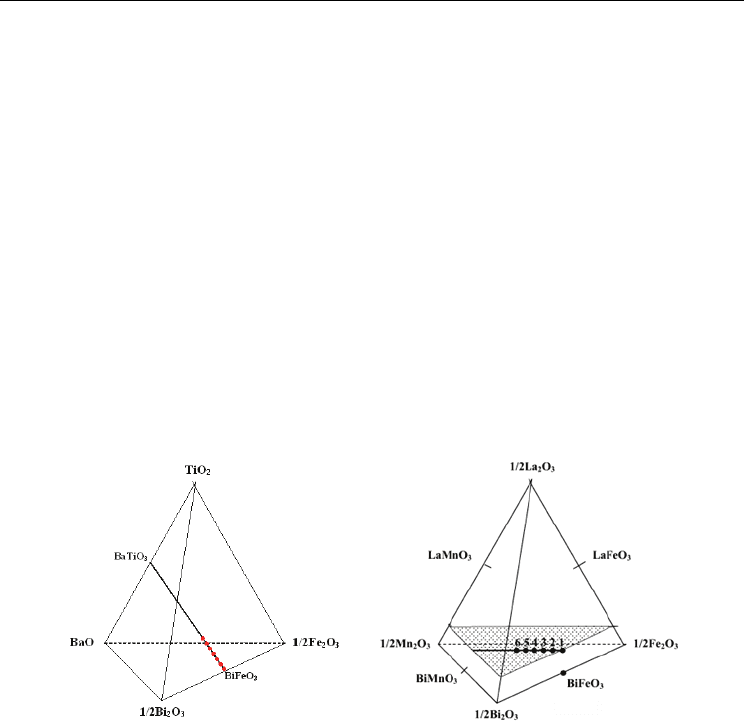
Effects of Doping and Oxygen Nonstoichiometry on the
Thermodynamic Properties of Some Multiferroic Ceramics
349
2. Experimental
2.1 Sample preparation
(1-x)BiFeO
3
– xBaTiO
3
(0 ≤ x ≤ 0.30) ceramic samples were prepared by classical solid state
reaction method from high purity oxides and carbonates: Bi
2
O
3
(Fluka), Fe
2
O
3
(Riedel de
Haen), TiO
2
(Merck) and BaCO
3
(Fluka), by a wet homogenization technique in isopropyl
alcohol. The place of the selected compositions on the BiFeO
3
– BaTiO
3
tie line of the
quaternary Bi
2
O
3
– BaO – Fe
2
O
3
–TiO
2
system is also presented in Fig. 1(a).
The mixtures were granulated using a 4 % PVA (polyvinyl alcohol) solution as binder agent,
shaped by uniaxial pressing at 160 MPa into pellets of 20 mm diameter and ~3 mm
thickness. The presintering thermal treatment was carried out in air, at 923 K, with 2 hours
plateau. The samples were slowly cooled, then ground, pressed again into pellets of 10 mm
diameter and 1- 2 mm thickness and sintered in air, with a heating rate of 278 K/min, for 1
hour at 973 and 1073 K, respectively (Ianculescu, 2000; Prihor, 2009; Prihor Gheorghiu,
2010).
Bi
0.9
La
0.1
Fe
1−x
Mn
x
O
3
(0 ≤ x ≤ 0.5) ceramics have been prepared by the same route, in the same
conditions and starting from the same raw materials (Ianculescu, 2009). The place of the
investigated compositions in the quaternary Bi
2
O
3
– La
2
O
3
– Fe
2
O
3
– Mn
2
O
3
system is
presented in Fig. 1(b).
Fig. 1. Place of the investigated compositions: (a) Bi
1-x
Ba
x
Fe
1-x
Ti
x
O
3
in the quaternary Bi
2
O
3
–
BaO – Fe
2
O
3
–TiO
2
system; (b) Bi
0.9
La
0.1
Fe
1-x
Mn
x
O
3
in the quaternary Bi
2
O
3
– La
2
O
3
– Fe
2
O
3
–
Mn
2
O
3
system
2.2 Sample characterization
In both Bi
1-x
Ba
x
Fe
1-x
Ti
x
O
3
and Bi
0.9
La
0.1
Fe
1−x
Mn
x
O
3
systems, the phase composition and
crystal structure of the ceramics resulted after sintering were checked with a SHIMADZU
XRD 6000 diffractometer with Ni-filtered CuKα radiation (λ = 1.5418 Å), 273.02 K scan step
and 1 s/step counting time. To estimate the structural characteristics (unit cell parameter
and rhombohedral angle) the same step increment but with a counting time of 10 s/step, for
2θ ranged between 293–393 K was used. Parameters to define the position, magnitude and
shape of the individual peaks are obtained using the pattern fitting and profile analysis of
the original X-ray 5.0 program. The lattice constants calculation is based on the Least
Squares Procedure (LSP) using the linear multiple regressions for several XRD lines,
depending on the unit cell symmetry.
(a)
(b)

Ferroelectrics – Physical Effects
350
A HITACHI S2600N scanning electron microscope SEM coupled with EDX was used to
analyze the ceramics microstructure.
The solid-oxide electrolyte galvanic cells method was employed to obtain the
thermodynamic properties of the samples. As shown in previous papers (Tanasescu, 1998,
2003, 2009) the thermodynamic stability limits of the ABO
3-δ
perovskite-type oxides are
conveniently situated within the range of oxygen chemical potentials that can be measured
using galvanic cells containing 12.84 wt.% yttria stabilized zirconia solid electrolyte and an
iron-wüstite reference electrode. The design of the apparatus, as well as the theoretical and
experimental considerations related to the applied method, was previously described
(Tanasescu, 1998, 2011).
The measurements were performed in two principal different ways:
• Under the open circuit conditions, keeping constant all the intensive parameters, when
the electromotive force (EMF) measurements give information about the change in the
Gibbs free energy for the virtual cell reaction. The EMF measurements were performed
in vacuum at a residual gas pressure of 10
-7
atm. The free energy change of the cell is
given by the expression:
ΔG
cell
=
2
O
μ
-
2(ref)
O
μ
= 4FE (1)
where E is the steady state EMF of the cell in volts;
2
O
μ
,
2(ref)
O
μ
are respectively, the oxygen
chemical potentials of the sample and the reference electrode and F is the Faraday constant
(F=96.508 kJ/V equiv.).
By using the experimental values of the electromotive force of the cell and knowing the free
energy change of the reference electrode (Charette, 1968; Kelley 1960, 1961), the values of the
relative partial molar free energy of the solution of oxygen in the perovskite phase and
hence the pressures of oxygen in equilibrium with the solid can be calculated:
2
O
O
2
lnGRTpΔ=
(2)
The relative partial molar enthalpies and entropies were obtained according to the known
relationships (Tanasescu, 1998, 2011):
2
O
2
O
2
G
H
T
T
T
Δ
∂
Δ
=−
∂
(3)
2
22
O
OO
GHTSΔ=Δ−Δ
(4)
The overall uncertainty due to the temperature and potential measurement (taking into
account the overall uncertainty of a single measurement and also the quoted accuracy of the
voltmeter) was ±1.5 mV. This was equivalent to ±0.579 kJ mol
-1
for the free energy change of
the cell. Considering the uncertainty of ±0.523 kJ mol
-1
in the thermodynamic data for the
iron-wüstite reference (Charette, 1968; Kelley 1960, 1961), the overall data accuracy was
estimated to be ±1.6 kJ mol
-1
. For the enthalpies the errors were ±0.45 kJ mol
-1
and for the
entropies ±1.1 J mol
-1
K
-1
. Errors due to the data taken from the literature are not included in
these values because of the unavailability of reliable standard deviations.

Effects of Doping and Oxygen Nonstoichiometry on the
Thermodynamic Properties of Some Multiferroic Ceramics
351
• By using a coulometric titration technique coupled with EMF measurements
(Tanasescu, 2011), method which proved to be especially useful in the study of the
compounds with properties highly sensitive to deviations from stoichiometry. The
obtained results allow us to evidence the influence of the oxygen stoichiometry change
on the thermodynamic properties. The titrations were performed
in situ at 1073 K by
using a Bi-PAD Tacussel Potentiostat. A constant current (
I) is passed through the cell
for a predetermined time (
t). Because the transference number of the oxygen ions in the
electrolyte is unity, the time integral of the current is a precise measure of the change in
the oxygen content (Tanasescu, 1998; 2011). According to Faraday's law, the mass
change
mΔ
(g) of the sample is related to the transferred charge Q (A·sec) by:
m
Δ
= 8.291·10
-5
Q (5)
As one can see, a charge of 1·10
-5
A sec, which is easily measurable corresponds to a weight
change of only 8x 10
-10
g. This makes it possible to achieve extremely high compositional
resolution, and very small stoichiometric widths in both deficient and excess oxygen
domains can be investigated. Thus, the effect of the oxygen stoichiometry can be correlated
with the influence of the A- and B-site dopants.
After the desired amount of electricity was passed through the cell, the current circuit was
opened, every time waiting till the equilibrium values were recorded (about three hours).
Practically, we considered that EMF had reached its equilibrium value when three
subsequent readings at 30 min intervals varied by less than 0.5 mV. After the sample
reached equilibrium, for every newly obtained composition, the temperature was changed
under open-circuit condition, and the equilibrium EMFs for different temperatures between
1073 and 1273 K were recorded.
Differential scanning calorimetric measurements were performed with a
SETSYS Evolution
Setaram
differential scanning calorimeter (Marinescu, in press; Tanasescu, 2009). For data
processing and analyses the Calisto–AKTS software was used. The DSC experiments were
done on ceramic samples under the powder form, at a heating rate 10°C/min. and by using
Ar with purity > 99.995% as carrier gas. For measurements and corrections identical
conditions were set (Marinescu, in press). The critical temperatures corresponding to the
ferro-para phase transitions, the corresponding enthalpies of transformations as well as heat
capacities were obtained according to the procedure previously described (Marinescu, in
press; Tanasescu, 2009).
3. Results and discussion
3.1 BiFeO
3
-BaTiO
3
system
3.1.1 Phase composition and crystalline structure
The room temperature XRD patterns (Fig. 2(a)) show perovskite single-phase, in the limit of
XRD accuracy for all the investigated compositions after pre-sintering at 923 K/2 h followed
by sintering at 1073 K/1 h and slow cooling. For all investigated ceramics, perovskite
structure of rhombohedral R3c symmetry was identified, with a gradual attenuation of the
rhombohedral distortion with the increase of BaTiO
3
content. This tendency to a gradual
change towards a cubic symmetry with the BaTiO
3
addition is proved by the cancellation of
the splitting of the XRD (110), (111), (120), (121), (220), (030) maxima specific to pure BiFeO
3
(2
θ ≈ 31.5
o
, 39
o
, 51
o
, 57
o
, 66
o
, 70
o
, 75
o
), as observed in the detailed representation from Fig.
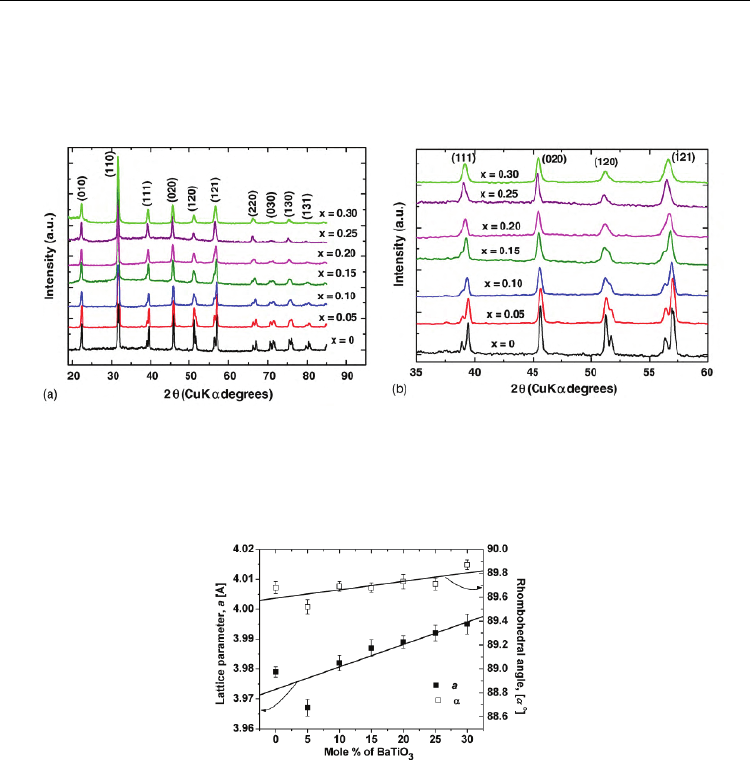
Ferroelectrics
– Physical Effects
352
2(b). The evolution of the structural parameters provides an additional evidence for the
influence of BaTiO
3
admixture in suppressing rhombohedral distortion (Fig. 3). Besides, the
expansion of the lattice parameters induced by an increasing barium titanate content in
(1−x)BiFeO
3
– xBaTiO
3
system was also pointed out (Prihor, 2009).
Fig. 2. (a) Room temperature X-ray diffraction patterns of the (1−x)BiFeO
3
– xBaTiO
3
ceramics pre-sintered at 923 K/2 h, sintered at 1073 K/1 h and slow cooled; (b) detailed XRD
pattern showing the cancellation of splitting for (1 1 1), (1 2 0) and (1 2 1) peaks, when
increasing x.
Fig. 3. Evolution of the structural parameters versus BaTiO
3
content.
3.1.2 Microstructure
Surface SEM investigations were performed on both presintered and sintered samples. The
SEM image of BiFeO
3
ceramic obtained after presintering at 923 K shows that the
microstructure consists of intergranular pores and of grains of various size (the average
grain size was estimated to be ~ 20 μm), with not well defined grain boundaries, indicating
an incipient sintering stage (Fig. 4(a)). The SEM images of samples with x = 0.15 and x = 0.30
(Figs. 4(b) and 4(c)) indicate that barium titanate addition influences drastically the
microstructure. Thus, one can observe that BaTiO
3
used as additive has an inhibiting effect
on the grain growth process and, consequently, a relative homogeneous microstructure,
with a higher amount of intergranular porosity and grains of ~ one order of magnitude
smaller than those ones of non-modified sample, were formed in both cases analyzed here.
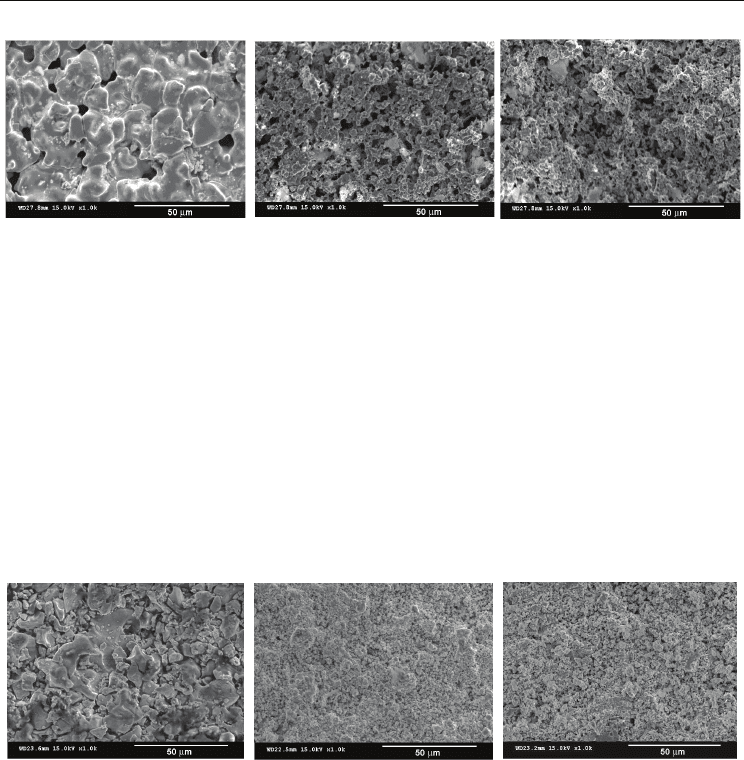
Effects of Doping and Oxygen Nonstoichiometry on the
Thermodynamic Properties of Some Multiferroic Ceramics
353
Fig. 4. Surface SEM images of (1-x)BiFeO
3
– xBaTiO
3
ceramics obtained after presintering at
923 K/2 hours: (a) x = 0, (b) x = 0.15 and (c) x = 0.30
BiFeO
3
pellet sintered at 1073 K/1h exhibits a heterogeneous microstructure with bimodal
grain size distribution, consisting from large grains with equivalent average size of ~ 25 μm
and small grains of 3 - 4
μm (Fig. 5(a)). The micrograph of the ceramic sample with x = 0.15
(Fig. 5(b)) shows that the dramatic influence of the BaTiO
3
on the microstructural features is
maintained also after sintering. Thus, a significant grain size decrease was observed for
sample with x = 0.15. Further increase of BaTiO
3
content to x = 0.30 (Fig. 5(c)) seems not to
determine a further drop in the average grain size. Consequently, in both cases a rather
monomodal grain size distribution and relative homogenous microstructures, consisting of
finer (submicron) grains were observed (Ianculescu, 2008; Prihor, 2009). Irrespective of
BaTiO
3
content, the amount of intergranular porosity is significantly reduced in comparison
with the samples resulted after only one-step thermal treatment. This indicates that sintering
strongly contributes to densification of the Bi
1-x
Ba
x
Fe
1-x
Ti
x
O
3
ceramics.
Fig. 5. Surface SEM images of (1-x)BiFeO
3
– xBaTiO
3
ceramics obtained after presintering at
923 K/2 hours and sintering at 1073 K/1 hour: (a) x = 0, (b) x = 0.15 and (c) x = 0.30
3.1.3 Thermodynamic properties of Bi
1-x
Ba
x
Fe
1-x
Ti
x
O
3
Of particular interest for us is to evidence how the appropriate substitutions could influence
the stability of the Bi
1-x
Ba
x
Fe
1-x
Ti
x
O
3
perovskite phases and then to correlate this effect with
the charge compensation mechanism and the change in the oxygen nonstoichiometry of the
samples.
In a previous work (Tanasescu, 2009), differential scanning calorimetric experiments were
performed in the temperature range of 773-1173 K in order to evidence the ferro-para phase
transitions by a non-electrical method. Particular attention is devoted to the high
temperature thermodynamic data of these compounds for which the literature is rather
scarce. Both the temperature and composition dependences of the specific heat capacity of
(c)
(a) (c) (b)
(a) (b) (c)

Ferroelectrics
– Physical Effects
354
the samples were determined and the variation of the Curie temperature with the
composition was investigated. The effect of the BaTiO3 addition to BiFeO3 was seen as the
decrease of the Curie transition temperature and of the corresponding enthalpy of
transformation and heat capacity values (Tanasescu, 2009) (Fig. 6). A sharp decline in the
T
C
was pointed out for BiFeO
3
rich compositions (Fig. 6). In fact, the Cp of the rhombohedral
phase (x = 0) is obviously larger than that of the Bi
1-x
Ba
x
Fe
1-x
Ti
x
O
3
perovskite phases,
whereas the
Cp of each phase shows a weak composition dependence below the peak
temperature. In particular, the value of
Cp for x = 0.3 was found to be fairly low, which we
did not show in the figure. The decreasing of the ferroelectric – paraelectric transition
temperature with the increase of the BaTiO
3
amount in the composition of the solid
solutions with x = 0 ÷ 0.15 indicated by the DSC measurements is in agreement with the
dielectric data reported by Buscaglia et al (Buscaglia, 2006).
Some reasons for this behaviour could be taken into account. First of all, these results
confirm our observations that the solid solution system BiFeO
3
– BaTiO
3
undergoes
structural transformations with increasing content of BaTiO
3
. The decrease of the
ferroelectric-paraelectric transition temperature
Tc observed for the solid solution (1-
x)BiFeO
3
– xBaTiO
3
may be ascribed to the decrease in unit cell volume caused by the
BaTiO
3
addition. Addition of Ba
2+
having empty p orbitals, reduces polarization of core
electrons and also the structural distorsion. The low value obtained for
Cp at x = 0.3 is in
accordance with the previous result indicating that ferroelectricity disappears in samples
above x ~ 0.3 (Kumar, 2000).
Fig. 6. Variation of the Curie transition temperature
T
C
and of the heat capacity Cp with
composition. Inset: Variation of
T
C
and enthalpy of transformation for BiFeO
3
rich
compositions (x=0; 0.05; 0.1) (Tanasescu, 2009)
At the same time, the diffused phase transitions for compositions with x > 0.15 could be
explained in terms of a large number of A and B sites occupied by two different, randomly
distributed cationic specimens in the perovskite ABO
3
lattice. Previous reports on the
substituted lanthanum manganites indicate that the mismatch at the A site creates strain on
grain boundaries which affect the physical properties of an ABO
3
perovskite (Maignan,
2000). Besides, the role of charge ordering in explaining the magnetotransport properties of
the variable valence transition metals perovskite was emphasized (Jonker, 1953).
Investigating the influence of the dopants and of the oxygen nonstoichiometry on spin
dynamics and thermodynamic properties of the magnetoresistive perovskites, Tanasescu et
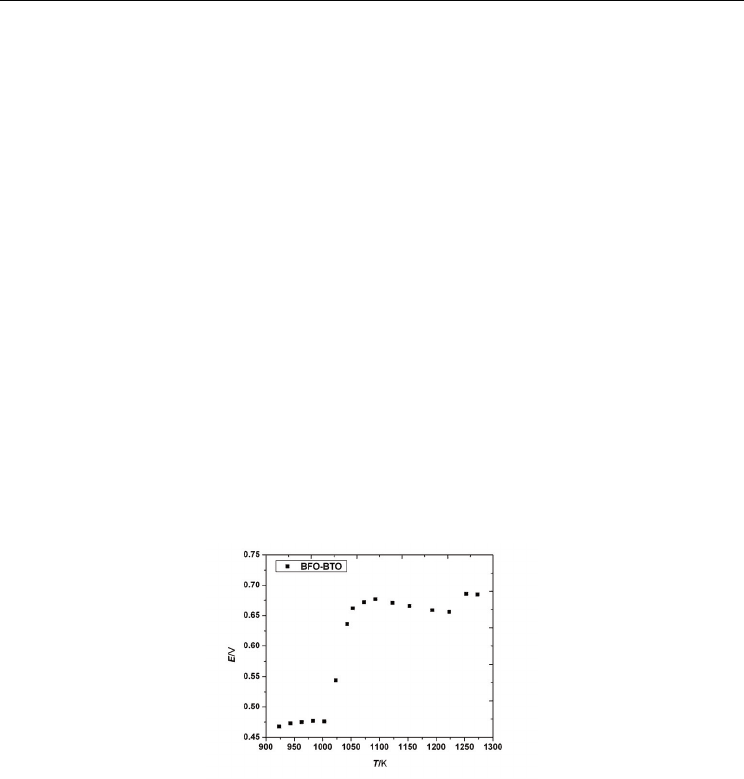
Effects of Doping and Oxygen Nonstoichiometry on the
Thermodynamic Properties of Some Multiferroic Ceramics
355
al (Tanasescu, 2008, 2009) pointed out that the remarkable behaviour of the substituted
samples could be explained not only qualitatively by the structural changes upon doping,
but also by the fact that the magneto-transport properties are extremely sensitive to the
chemical defects in oxygen sites.
Though the effects of significant changes in the overall concentration of defects is not fully
known in the present system of materials, extension of the results obtained on substituted
manganites, may give some way for the correlation of the electrical, magnetic and
thermodynamic properties with the defect structure. The partial replacement of Bi
3+
with
Ba
2+
cations acting as acceptor centers could generate supplementary oxygen vacancies as
compensating defects, whereas the Ti
4+
solute on Fe
3+
sites could induce cationic vacancies
or polaronic defects by Fe
3+
→ Fe
2+
transitions. The presence of the defects and the change of
the Fe
2+
/ Fe
3+
ratio is in turn a function not only of the composition but equally importantly
of the thermal history of the phase. Consequently, an understanding of the high temperature
defect chemistry of phases is vital, if an understanding of the low temperature electronic
and magnetic properties is to be achieved. To further evaluate these considerations, and
in order to discriminate against the above contributions, experimental insight into the
effects of defect types and concentrations on phase transitions and thermodynamic data
could give a valuable help.
For discussion was chosen the compound Bi
0.90
Ba
0.10
Fe
0.90
Ti
0.10
O
3
for which strong
magnetoelectric coupling of intrinsic multiferroic origin was reported (Singh, 2008). The
results obtained in the present study by using EMF and solid state state coulometric titration
techniques are shown in the following.
Fig. 7. Temperature dependence of EMF for Bi
0.90
Ba
0.10
Fe
0.90
Ti
0.10
O
3
The recorded EMF values obtained under the open circuit condition in the temperature
range 923-1273 K are presented in Fig. 7. The thermodynamic data represented by the
relative partial molar free energies, enthalpies and entropies of the oxygen dissolution in the
perovskite phase, as well as the equilibrium partial pressures of oxygen have been
calculated and the results are depicted in Figs. 8-11. A complex behavior which is dependent
on the temperature range it was noticed, suggesting a change of the predominant defects
concentration for the substituted compound.
As one can see in Fig. 7, at low temperatures, between 923 and ~1000 K, EMF has practically
the same value
E=0.475 V. Then, Fig. 7 distinctly shows a break in the EMF vs. temperature
relation at about 1003 K, indicating a sudden change in the thermodynamic parameters. A
strong increase of the partial molar free energy and of the partial pressure of oxygen was
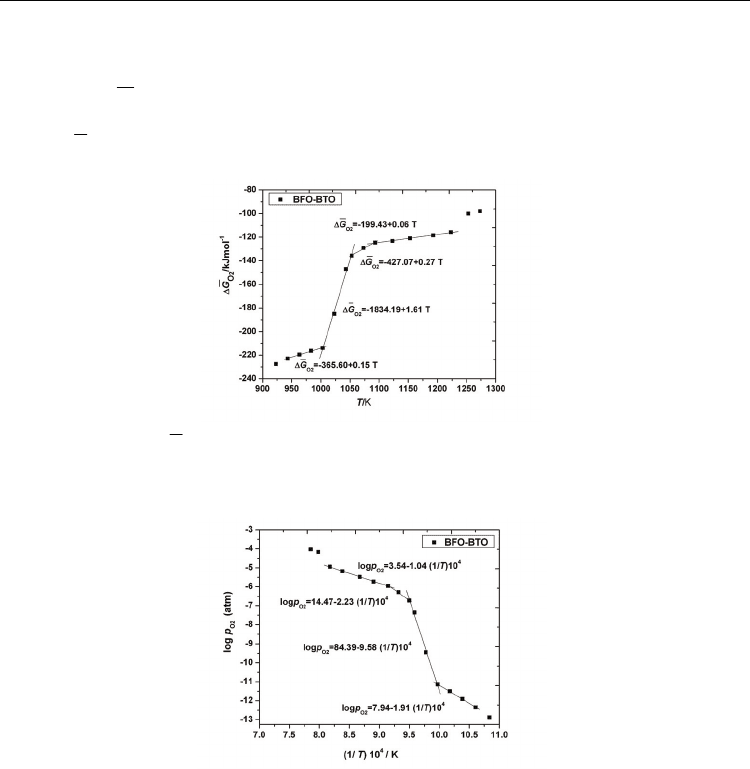
Ferroelectrics
– Physical Effects
356
observed until 1050 K (Figs. 8 and 9) which can be due to structural transformation related
to the charge compensation of the material system. Then, on a temperature interval of about
40 K the increasing of the energies values is smaller. After ~ 1090 K a new change of the
slope in the
2
O
ΔG and
2
O
log p variation is registered on a temperature interval of about 130
degrees, followed again, after 1223 K, by a sudden change of the thermodynamic data, the
higher
2
O
ΔG value being obtained at about 1260 K.
Fig. 8. Variation of
2
O
ΔG with temperature - linear fit in the selected temperature ranges:
943-1003 K, 1003-1053 K, 1053-1093 K and 1093-1223 K
Fig. 9. The plot of
2
log
O
p
vs. 1/T for the selected temperatures ranges
The break point at about 1003 K is mainly due to first order phase transition in
Bi
0.90
Ba
0.10
Fe
0.90
Ti
0.10
O
3
associated with the ferroelectric to the paraelectric transition T
C
. The
10% BaTiO
3
substitution reduces the ferroelectric transition temperature of BiFeO
3
with
about 100K
.
This transition is also evident from calorimetric measurements (Tanasescu,
2009). The less abrupt first order transition at 1050 K is qualitatively in concordance with the
transition to the
γ
polymorph which was previously identified in the literature for BiFeO
3
at
1198-1203K (Arnold, 2010; Palai, 2008; Selbach, 2009).
In Fig. 10 we represented the partial molar free energies of oxygen dissolution obtained in
this study for both Bi
0.90
Ba
0.10
Fe
0.90
Ti
0.10
O
3
and BiFeO
3
at temperatures lower than their
specific ferroelectric transition temperatures. We would like to specify that in the case of
BiFeO
3
, the EMF measurements were performed at temperatures not higher than 1073 K due
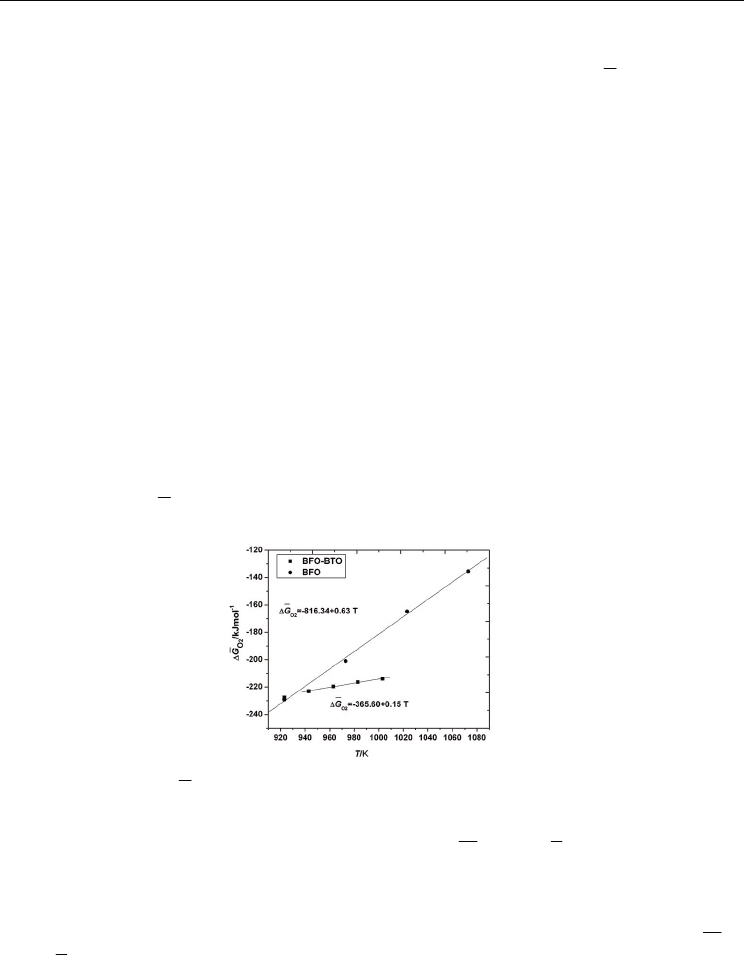
Effects of Doping and Oxygen Nonstoichiometry on the
Thermodynamic Properties of Some Multiferroic Ceramics
357
to the instability of BiFeO
3
at higher temperatures. As one can see in Fig. 10, at 923 K, the
partial molar free energies of oxygen dissolution in BiFeO
3
and Bi
0.90
Ba
0.10
Fe
0.90
Ti
0.10
O
3
samples are near each other. With increasing temperature, the highest
2
O
ΔG values were
obtained for BiFeO
3
, suggesting an increased oxygen vacancies concentration in this
compound. The result could be explained by the fact that at low temperatures the
conduction is purely intrinsic and the anionic vacancies created are masked by impurity
conduction. As the temperature increases, conduction becomes more extrinsic (Warren,
1996), and conduction due to the oxygen vacancies surface. This fact is also evident from the
density measurements (Kumar, 2000), as well as electron paramagnetic resonance studies on
perovskites (Warren, 2006). The increased concentration of oxygen vacancies in BiFeO
3
is
consistent with the large leakage current reported for BiFeO
3
(Gu, 2010; Qi, 2005; Palkar,
2002; Wang, 2004). The electrical characteristics (Qi, 2005) indicated that the main
conduction mechanism for pure BFO was space charge limited, and associated with free
carriers trapped by oxygen vacancies. The coexistence of Fe
3+
and Fe
2+
causes electron
hopping between Fe
3+
and Fe
2+
ions, oxygen vacancies acting as a bridge between them,
which increases the leakage current. According to the defect chemistry theory, doping
BiFeO
3
with aliovalent ions should change the oxidation state of iron and the concentration
of oxygen vacancies. Qi and coworkers (Qi, 2005) have suggested as possible mechanisms to
achieve the charge compensation in the 4+ cation-doped material: filling of oxygen
vacancies, decrease of cation valence by formation of Fe
2+
, and creation of cation vacancies.
Based on our results, the doping with Ti
4+
is expected to eliminate oxygen vacancies causing
the decreasing of
2
O
ΔG and
2
log
O
p
values.
Fig. 10. Variation of
2
O
ΔG
with temperature - linear fit in the temperature range 943-1003 K
for Bi
0.90
Ba
0.10
Fe
0.90
Ti
0.10
O
3
(BFO-BTO) and 923-1073 K for BiFeO
3
(BFO)
Further clarification could be achieved by determining
2
O
HΔ and
2
O
SΔ values in particular
temperature ranges in which the partial molar free energies are linear functions of
temperature. Comparing the values obtained for Bi
0.90
Ba
0.10
Fe
0.90
Ti
0.10
O
3
in the temperature
interval of 943-1003 K with the corresponding enthalpies and entropies values of BiFeO
3
in
the 923-1073 K range (Fig. 11) one can observe that for the substituted compound,
2
O
HΔ
and
2
O
SΔ
values strongly increase (with ~450 kJ mol
-1
and ~480 J mol
-1
K
-1
respectively).
This finding can be explained by the relative redox stability of the B-site ions which seems to
modify both the mobility and the concentration of the oxygen vacancies. It is interesting to
note that increasing temperature, after the first transition point, the enthalpies and entropies
values strongly decrease (with ~ 468 kJ mol
-1
and ~1.4 kJ mol
-1
K
-1
respectively) up to more
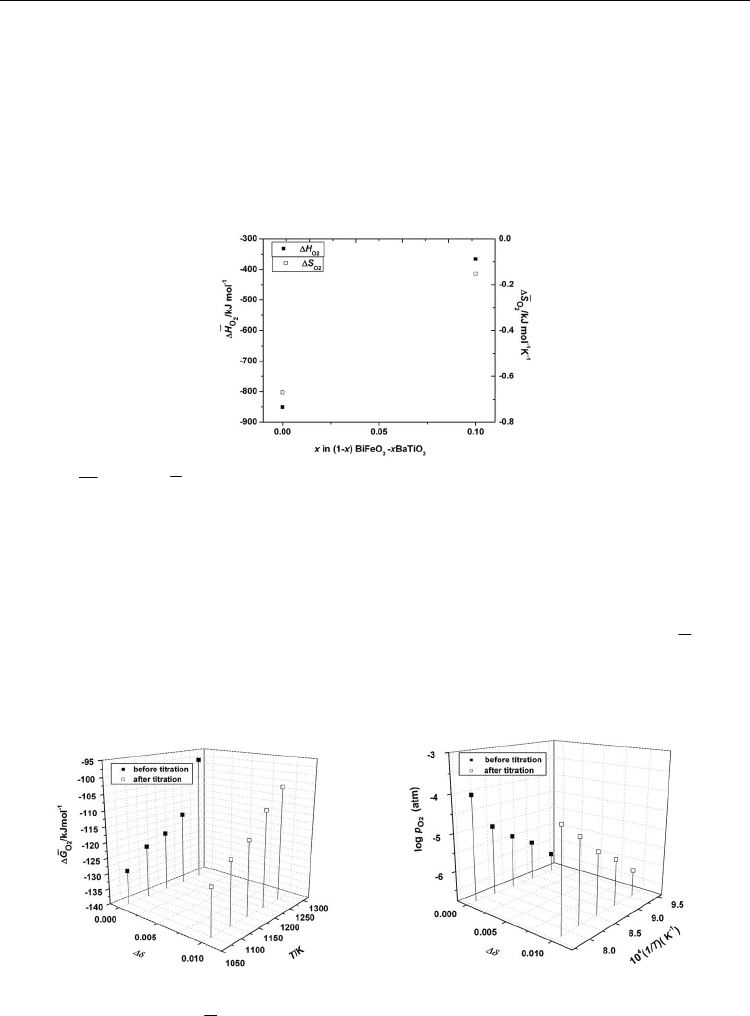
Ferroelectrics
– Physical Effects
358
negative values. The negative values obtained for the relative partial entropies of oxygen
dissolution at high temperature are indicative for a metal vacancy mechanism. Above 1053
K both the enthalpy and entropy increase again with increasing the temperature. The
thermal reduction for transition metals tends to be easier with Ba doping. These may explain
the reason for the different behaviors at higher temperature zone. Besides, oxygen vacancy
order also show contribution to the observed phenomena, the increasing of the enthalpy and
entropy values being an indication that the oxygen vacancies distribute randomly on the
oxygen sublattice.
Fig. 11.
2
O
HΔ and
2
O
SΔ as a function of BaTiO
3
content (x) at temperatures lower than
ferroelectric transition temperatures.
In order to further evaluate the previous results, the influence of the oxygen stoichiometry
change on the thermodynamic properties has to be examined. The variation of the
thermodynamic data of oxygen deficient Bi
0.90
Ba
0.10
Fe
0.90
Ti
0.10
O
3-
δ
samples was analyzed at
the relative stoichiometry change Δ
δ = 0.01. In Figures 12 (a) and (b), two sets of data
obtained before and after the isothermal titration experiments are plotted. Higher
2
O
ΔG and
2
log
O
p
values are obtained after titration at all temperatures until 1223 K; above 1223 K, the
values after titration are lower than the corresponding values before titration.
(a) (b)
Fig. 12. Variation of (a)
2
O
ΔG
and (b)
2
log
O
p
with temperature and oxygen stoichiometry
change for Bi
0.90
Ba
0.10
Fe
0.90
Ti
0.10
O
3
